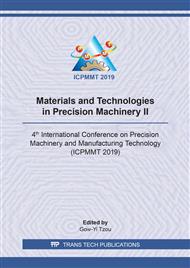[1]
G. Centeno, M.B. Silva, L. M. Alves, C. Vallellano, Towards the characterization of fracture in thin-walled tube forming, Int. J. Mech. Sci., 119, 12-22, (2006).
DOI: 10.1016/j.ijmecsci.2016.10.001
Google Scholar
[2]
C. J. Tana, W. T. Chonga, M. A. Hassama, End formation of a round tube into a square section having small corner radii, J. Mater. Process. Technol., 213, 1465-1474, (2013).
DOI: 10.1016/j.jmatprotec.2013.03.021
Google Scholar
[3]
L. Venugopal, M. J. Davidson, N. Selvaraj, Analysis of tube end forming process using Taguchi design of experiments, UUJMS, 2, 137-145, (2013).
Google Scholar
[4]
XinMing Qiu, LiangHong He, Jie Gu, XiaoHuan Yu, A three-dimensional model of circular tube under quasi-static external free inversion., Int. J. Mech. Sci., 75, 87-93, (2013).
DOI: 10.1016/j.ijmecsci.2013.06.009
Google Scholar
[5]
A. Ghamarian, M. T. Abadi, Axial crushing analysis of end-capped circular tubes, Thin. Wall. Struct., 49, 743-752, (2011).
DOI: 10.1016/j.tws.2011.01.006
Google Scholar
[6]
C. M. A. Silva, C. V. Nielsen, L. M. Alves, P. A. F. Martins, Environmentally friendly joining of tubes by their ends, J. Clean. Prod., 87, 777-786 (2015).
DOI: 10.1016/j.jclepro.2014.10.022
Google Scholar
[7]
G Centeno, M.B. Silva, L.M. Alves, C. Vallellano, P.A.F. Martins, On the Utilization of Circle Grid Analysis in Thin-walled Forming of Tubes: Experimental and Numerical Evaluation, Procedia Engineering , 207, 1773-1778, (2017).
DOI: 10.1016/j.proeng.2017.10.937
Google Scholar
[8]
YuZhe Liu, XinMing Qiu, A theoretical model of the shrinking metal tubes, Int. J. Mech. Sci., 144, 564-575, (2018).
Google Scholar
[9]
L.M. Alves, E. J. Dias, P. A. F. Martins, Joining sheet panels to thin-walled tubular profiles by tube end forming, J. Clean. Prod., 19, 712-719. (2011).
DOI: 10.1016/j.jclepro.2010.12.014
Google Scholar
[10]
L. M. Alves, C.M.A Silva, P.A.F Martins, End-to-end joining of tubes by plastic instability, J. Mater. Process. Tech. 214, 1954-1961, (2014).
DOI: 10.1016/j.jmatprotec.2014.04.011
Google Scholar
[11]
L.M. Alves, C.V. Nielsen, C.M.A. Silva, P.A.F. Martins, Joining end-to-end tubing of dissimilar materials by forming, Int. J. Pres. Ves. Pip. 149, Pages 24-32, (2017).
DOI: 10.1016/j.ijpvp.2016.11.006
Google Scholar
[12]
L.M. Alves, C.M.A. Silva, P.A.F. Martins, Joining of tubes by internal mechanical locking, J. Mater. Process. Tech. 242, 196-204, (2017).
DOI: 10.1016/j.jmatprotec.2016.11.037
Google Scholar
[13]
JIS., Metallic materials-Tensile testing-Method of test at room temperature, JIS Z 2241:2011, Japan, 27-44. (2011).
Google Scholar


